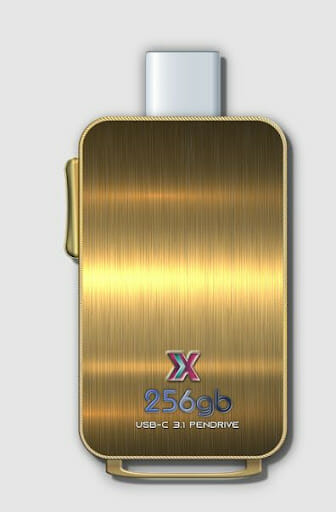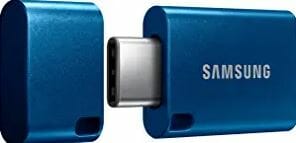USB-C memory sticks are data storage devices for USB type-C devices. The flash drives integrate a 24-pin type-C connector and came to inception in the tech world in 2014 as successors to USB-B and USB Type A. USB-C memory sticks are imperative for storage, supplementary back-ups, and transferring electronic files. Read further as we elaborate more regarding USB-C memory sticks!
Table Of Contents
Key Takeaways
- USB-C memory sticks are essential in modern computing as more devices shift towards USB-C ports.
- USB-C memory sticks offer several advantages over traditional USB drives, such as durability, faster data transfer, security features, and compatibility with modern devices.
- Users must consider compatibility issues when using USB-C memory sticks with older devices lacking USB-C ports.
USB-C Flash Drives
Also recognized as a thumb drive, memory stick, or pen drive, the USB-C flash drive is a data storage device including flash memory with an integrated USB type-C connector interface. The first 24-pin USB-C connector was first released in August 2014 by USB Implementer Forum.
The USB-C flash drives come in varying storage capacities depending on the exact type of memory chip used. These memory devices can store over 2 terabytes (TB). They are heavily incorporated in desktops, tablets, Smartphones, docking stations, monitors, and scanners.
USB-C Flash Drive Amazon: Samsung MUF-128DA
Amazon has vast types of USB-C flash drives with varying storage capacities. The Samsung MUF-128DA is a high-speed memory stick delivering speeds of up to 400MB/s. The flash drive integrates a durable USB Type-C connector.
Other examples of USB-C flash drives available at Amazon include:
Advantages of USB-C Flash Drives Over Traditional Ones
- USB-C delivers faster data transfer speeds
- It supports reversible insertion
- Efficient and safer to use
- Highly durable to withstand over 10000 insertion and removal cycles
- Some USB-C flash drives offer advanced security features like encryption and password protection, which can protect your data from unauthorized access
Related: Mini USB vs Micro USB: What Are The Differences?
How Do I Use a USB-C Memory Stick?
USB sticks keep temporary essential files like CVS, medical records, and contact lists. Here is the step-by-step process on how to use a USB-C memory stick;
Step 1: Insert the memory stick into a USB connection port on your PC
Step 2: Upon plugging in, press the Windows icon on your keyboard and search ‘This PC.’ Click My PC on the file explorer to view your USB drive folder.
Step 3: Open the USB memory drive to save or copy files
Step 4: Don’t unplug your storage device from your computer while transferring, as you could lose data. Check for the notification area. Safely remove hardware and eject media icon.
Step 5: Click on the USB-C device to remove
Step 6: Windows will display a notification indicating whether the drive is in use or whether it’s safe to remove.
https://youtu.be/_BapmrFC7Zw
Differences in Usage Compared to Traditional USB Drives
Their design is the most notable difference between USB-A and USB-C memory sticks. USB-A has a unidirectional input, whereas USB-C has a reversible input. You might need to flip the USB-A memory stick to find the right direction to plug it into your device, while the USB-C has no right or wrong way to plug it into your device.
Unlike USB-A, USB-C can handle more power delivery. Therefore, it can be attached to various peripherals on your computer. The USB-C flash drives were designed for high performance in data transfer. Related: Mini USB vs. Micro USB: What Are The Differences?
Compatibility Issues with Older Devices
The USB-C is compatible with numerous modern connection types, such as HDMI, whereas the USB type-A is compatible with older devices. USB-C can be configured to implement third-party interfaces.
USB-C flash drives can be used with older devices that do not have a USB-C port, as long as a USB-C to USB-A adapter is used.
What is the Fastest USB-C Memory Stick?
USB 2.0, USB 3.0, and USB 3.1 are USB standards that affect a USB’s speed. Most USB-C connectors are found in devices that support high data transfer rates, like USB 3.0 and USB 3.1. USB-C memory sticks are used for fast connections of up to 10 GB/s.
USB Type-C is based on the USB 3.1 standard. It has a starting speed of 5 GB/s and can be optimized to 40 GB/s with Thunderbolt 3.

You can easily transmit 4K videos via USB-C 3.1. Examples of readily available fastest USB-C memory sticks include;
Difference Between USB-C and USB-A Thumb Drive
USB-A and USB-C are the most common USB connections. USB-A is a standard connection port for most PCs and laptops, while the inception of USB-C has facilitated advanced capabilities in host systems. Both connections are crucial in data transfer and charging.
Older laptops still rely on older USB Type-A connection. Type-C integrates a reversible feature to provide reliability in newer Smartphones and other host machines. Although Type-A and Type-C USB thumb drives offer similar functions, there are distinct variations, such as;
The flash drives incorporate different connector types. USB-A integrates a classic rectangular connector, whereas USB-C has an oblong shape (smaller rectangle with rounded sides).
USB-A is designed to withstand 1500 insertions and removal, whereas USB-C can withstand over 10000 insertions and removal cycles.
Advantages of USB-C over USB-A Thumb Drives
- USB-C far outstrips USB-A thumb drives because it has high power delivery support. This feature enhances faster charging capabilities and transfer speeds.
- USB Type-C is more compact with reversible connectivity (vertical orientation). Unlike USB-A, USB-C has no right or wrong side to plug in.
- USB-C doesn’t encounter a data bandwidth cap, unlike USB-A technology, where attaching multiple peripherals and devices can slow performance
USB-C Flash Drive for Android Phones
Consider a USB-C flash drive if you frequently transfer files from a PC to a Smartphone. USB-C connector offers more robust file transfer. An ideal flash drive for android should be able to read roughly 90-120 MB/s and write 20-50 MB/s. Premium memory sticks can boast up to 10Gbs/s over USB 3.2 support.

Image by Usbmemorydirect
USB-C Flash Drive Small: Silicon Power C80
The Silicon Power C80 is small in stature to prevent blocking any adjacent ports, even in compact devices. It is one of the most convenient thumb drives integrating a Type-C connector. The flash drive can swivel to protect the connector from getting bent or nicked.
Other small USB-C flash drives for phones include:
Advantages of Using a USB-C flash Drive on an Android Phone
- It connects to devices much faster and more conveniently
- The connector is symmetrical to allow connection upside down
- Compatible with delivering universal solutions with other connectors like display ports
- Delivers faster transfer rates.
Disadvantages
- The connection can interrupt the flow of data
- Plugging in suspicious flash drives can introduce malicious malware threats.
Related: How to Remove Write Protection From USB Drive in Windows 10
USB-C Dual Flash Drive
USB-C dual flash drives are storage devices with dual connectors to transfer files between multiple devices. They are designed with the USB Type-C reversible connector. The flash drives are compatible with smartphones, tablets, Macs, and USB Type-A computers.
USB-C has read speeds up to 150MB/s. Its write speeds vary by capacity and USB standard, such as USB 3.1/ USB 3.0 support. Examples of USB-C dual flash available in the market include;
- SCICNCE USB 3.0 Flash Drive 512GB Intended for iPhone
- SanDisk 512GB Ultra Dual Drive Go USB Type-C Flash Drive
- Verbatim Store ‘n’ Go 512GB USB Flash Drive 3.0
Advantages of Using a USB-C Dual Flash Drive
- Compatible with a wide array of devices
- Easy to move files between devices
- Faster transfer rate.
Disadvantage
- Non-compliant drives can spread malicious threats.
USB-C Memory Sticks FAQs
Is there a USB-C Flash Drive 1TB?
USB-C flash drives come in varying storage capacities; hence, you can get a 1TB flash drive to store or transfer large files.
What is a 512GB USB-C Flash Drive?
512GB flash drives are among the largest capacity USB-C flash drives currently available on the market. They are ideal for storing large files such as high-resolution photos, videos, and music libraries.
Conclusion
The USB-C memory stick has a flat round design and supports reverse insertion. They come in various storage capacities, sizes, and optimal speeds. There is no doubt that USB-C offers better data transfer rates.


